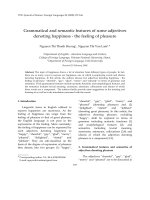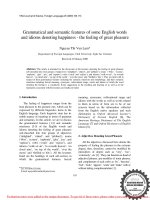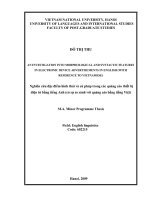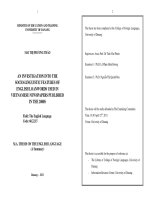An investigation into syntactic and semantic features of some english dimensional adjectives and their vietnamese equivalents
Bạn đang xem bản rút gọn của tài liệu. Xem và tải ngay bản đầy đủ của tài liệu tại đây (88.78 KB, 13 trang )
1
2
CHAPTER 1: INTRODUCTION
MINISTRY OF EDUCATION AND TRAINING
UNIVERSITY OF DANANG
*********
1.1. RATIONALE
Any entity in the material world always conceals a lot of
attributes. Among them, the attribute of dimension is easily seen and
HOÀNG THỊ HÒA
exists mainly in some commonly used dimensional adjectives such as
high-low, tall-short, long-short, deep-shallow, thick-thin, wide/
broad-narrow in English or cao-thấp, dài-ngắn, sâu-nông, dày-
AN INVESTIGATION INTO SYNTACTIC
AND SEMANTIC FEATURES OF SOME
mỏng, rộng-hẹp in Vietnamese. However, DAs are not completely
the same in English and in Vietnamese.
For example, in English, people say:
“The apple tree in our garden was seven meters tall. I didn’t
ENGLISH DIMENSIONAL ADJECTIVES
AND THEIR VIETNAMESE EQUIVALENTS
think that it was so high”
[9]
In the utterance above, tall and high are DAs used to indicate the
vertical extent of the apple tree but their meanings are different.
Field Study: THE ENGLISH LANGUAGE
Code
: 60.22.15.
“Tall” means “in relation to what one expects of it” while “high”
means “reaching a point above the normal level”. Unlike English,
Vietnamese only has the adjective “cao” to denote these two senses.
M.A. THESIS IN THE ENGLISH LANGUAGE
(A SUMMARY)
That leads to some semantic difficulties for learners of English as
well as translators.
Regarding the syntactic aspect, Vietnamese students may pay no
attention to the positions of DAs in a noun phrase or in a sentence.
Supervisor: NGUYỄN THỊ TUYẾT, M.A
For example, they may translate the sentence “Chị ấy là một phụ nữ
cao lớn” into English as “She is a woman tall”; in fact, it must be
DANANG, 2010
“She is a tall woman”.
3
4
Thus, a research on "syntactic and semantic features of some
•
Chapter 4: Discussion of findings.
dimensional adjectives in English and their Vietnamese equivalents"
•
Chapter 5: Conclusion and Implications.
is carried out in the hope to bring some theoretical and practical value
CHAPTER 2: LITERATURE REVIEW AND
for both linguistic study and language teaching methodology.
1.2. JUSTIFICATION OF THE STUDY
1.3. SCOPE OF THE STUDY
THEORETICAL BACKGROUND
2.1. A REVIEW OF PREVIOUS STUDIES
Clark, H.H. (1973) studied spatial relations which are mainly
In this study, we investigate the syntactic and semantic features
involved to the physical environment and human being physical and
of some English DAs (tall - short, high - low, deep - shallow, thick -
cognitive prerequisites. He introduced the terms P-space and L-space.
thin, wide - narrow, broad - narrow) and their VEs in the light of
Lyons, J. (1977) suggested a system regarding the DAs in English
cognitive linguistics. Due to the limitation of the study, we mainly
focus on examining unmarked adjectives tall, high, deep, thick, wide,
(long, short, high, low, deep, shallow, wide, narrow, thick, and thin.)
Cho, S.W. & O’Grady, W. (1991) studied DAs such as big, small,
broad on their spatial and non-metaphorical sense.
tall, long, short, high, low, thick, thin, wide, narrow, deep and
1.4. RESEARCH QUESTIONS
shallow.
(1).What are the common syntactic and semantic features of
some DAs in English and their VEs?
(2).What are the similarities and differences of the adjectives
indicating dimension in space between English and Vietnamese?
(3).What are the implications for English teaching, learning and
translation?
1.5. HYPOTHESIS
1.6. ORGANIZATION OF THE STUDY
This thesis is divided into five chapters.
•
Chapter 1: Introduction.
•
Chapter 2: Literature review and theoretical background .
•
Chapter 3: Methods and procedures.
Dirven and Taylor (1988) referred to global characteristics such as
profile against the background as well as to a dynamic interaction
with the environment in the case of tall.
Athanasiadou (2001) studied English broad and wide.
Taylor, J.R. (2002) discussed the semantic structure of two
prototypical adjectives: “tall” and “small”.
Moreover, the matter has been researched by Nguyễn Thị Dự
(2003) with the study of DAs to describe people, the adjective “deep”
in English or the spatial language in Vietnamese.
Đỗ Hữu Châu (1996) proposed DAs such as dài- ngắn, rộng-hẹp,
to-nhỏ, lớn-nhỏ, cao-thấp, sâu-nông, dày-mỏng, ect.
5
For Trần Văn Cơ (2007), the verticality of the human body decides
the tallness and length of entities.
In Lý Toàn Thắng’s view (2005), adjectives used to express the
attributes of spatial dimensions are cao, thấp, sâu, nông, etc.
In short, the concept of dimension has been introduced as a general
matter of linguistic aspects so far. However, the research into DAs in
certain languages is quite fragmented, and they are not a focal point
6
third type of notion is not tied to any particular domain, hence freely
applicable to any domain. Finally, Lakoff and Johnson [37] suggest
image schemas as basic notions. An image schema is derived from
our pre-conceptual bodily experience, or from physical experience
grounded in the body’s interaction with other physical objects.
2.2.2. Language Space
2.2.2.1. Some viewpoints on L-space
of the research. Particularly, there seem to be few studies on DAs in
Clark [23, p.28] says that our experience and perception of space
English and their VEs. Therefore, this study attempts to discover the
must precede any ability we acquire to talk about it. Clark calls that
related aspects still unsolved.
basic knowledge “perceptual space” (P-space). When we talk about
2.2. THEORETICAL BACKGROUND
it, however, we use what Clark terms “language space” (L-space).
2.2.1. Cognitive Linguistics
2.2.1.1. Cognition
Frawley [28, p.250 – 254] presents two fundamental ideas about
space and its representation in language.
In the view of Peter Gärdenfors [29], cognition includes “mental
Svorou [48, p.31] states that “To talk about space and spatial
processes connected with understanding formulation of believes and
relations … languages make use of a relatively small number of
acquisition of knowledge”.
elements.”
2.2.1.2. Brief Overview of Cognitive linguistics
Ungerer and Schmid [53] says that the language is comprehended
as an integrated part of our cognitive abilities. Pre-conceptual, prelinguistic experiences form the foundations for semantics.
Wierzbicka [54] proposes a natural semantic metalanguage, where
around 50 words are seen as semantic primitives. Langacker [39]
In the mind of Lý Toàn Thắng [17, p.57], space reflects the specific
features of a nation. Space is the most important category of
semantics, culture and consciousness.
Dư Ngọc Ngân [14, p.36] says that space reflects the realistic
domain with the existence of things in general and human in
particular.
discerns three types of basic conceptual entities. The first one is
Phan Khôi [13] says that time is much more important than space.
referred to as minimal concept in a particular domain. The second
Nguyễn Đức Dân [6, p.328] affirms that space has a very important
type is called experientially grounded conceptual archetypes. The
role in language.
7
When studying a category like space, according to Lý Toàn Thắng
[17, p.28], we need to distinguish three different notions about space:
8
According to Quirk et al [44], adjectives are classified into stative
and dynamic, gradable and non- gradable, inherent and non-inherent.
(a) the objective space of the physical world; (b) the subjective space
When studying the semantics of adjectives in the aspect of
which is the result of man’s cognition of the world and called
pragmatics, Đỗ Hữu Châu [4] proposes eight groups of monosyllable
perceptual space or projected space; (c) space shown in the semantics
adjectives in Vietnamese.
of spatial words and called language space.
2.2.2.2. General properties of L-space
Based on the researches into the semantics of spatial words by
In Cao Xuân Hạo’s view [11], the word “ cao” has the different
meanings.
2.2.4.3. Syntactic Functions of Adjectives
Leech (1969), Weirzbicka (1972), Lyons (1977), Talmy (1983),
(a) Attributive adjectives
Herskovits (1988), Lý Toàn Thắng [16, p.69] names some properties
(b) Predicative adjectives
and spatial relations.
(c) Adjectives function as head of a noun phrase
Furthermore, Clark [23, p.48] summarizes that L-space has
properties that are identical with those of P-space.
2.2.3. Basic Notions related to the Study of DAs
(d) Supplementative adjective clause
(e) Exclamatory adjective sentence
2.2.5. Dimensional Adjectives:
2.2.3.1. The Notion of Axis
2.2.5.1. Definition
2.2.3.2. The Notion of Spatial Orientation:
2.2.5.2. Some Notions in English
2.2.3.3. The Notion of “Point of Reference”
Clark [23] examined pairs of basic spatial adjectives in English.
2.2.3.4. The Notion of Direction
They are long – short, far – near, tall – short, high – low, deep –
2.2.3.5. The Notion of Position
shallow, wide – narrow, broad – narrow, and thick – thin.
2.2.3.6. The Notion of Markedness
In Lyons’s view [41], DAs have been used to illustrate antonyms.
2.2.3.7. The Structure of Egocentric Space:
He based on the shape, dimensionality and orientation of entities to
2.2.3.8. The Structure of Nonegocentric L-space
analyze the meaning of such DAs as long-short, high-low, deep-
2.2.4. An Overview of Adjectives
2.2.4.1. What is an Adjective?
2.2.4.2. Semantic Functions of Adjectives
shallow, wide-narrow, big-little, large-small and thick- thin.
In the view of Sook Whan Cho and William O’grady [43], DAs are
used to describe size and dimensions of objects.
9
2.2.4.2. Some Notions in Vietnamese
Nguyễn Hữu Quỳnh [15] mentions DAs such as: dài, ngắn, cao,
thấp, rộng, hẹp, gần, xa.
Đỗ Hữu Châu [5] states that DAs are pairs of antonyms such as
dài/ngắn, rộng/hẹp, to/nhỏ, lớn/nhỏ, cao thấp, sâu/nông, etc.
For Trần Văn Cơ [3], DAs such as cao/ thấp, dài/ ngắn are
determined by the vertical dimension of the human body.
10
3.1.2. Objectives:
• To analyze syntactic and semantic features of some DAs in
English.
• To point out the Vietnamese equivalents of some English
adjectives investigated.
• To find out the similarities and differences of DAs in the view of
the syntax and semantics between the two languages.
Furthermore, Nguyễn Thị Dự [7], [8], [9] proposes basic DAs in
• To make suggestions relating to DAs for teaching English to
English are long-short, tall-short, high-low, deep-shallow, wide,
Vietnamese students and translating these adjectives from English
broad-narrow, thick-thin and their Vietnamese equivalents are dài-
into Vietnamese and vice versa.
ngắn, cao-thấp, sâu-nông, rộng-hẹp, dày-mỏng. She also considers
3.2. RESEARCH DESIGN
that these adjectives refer to the material space abstracted in language
3.3. RESEARCH METHODOLOGY
along the vertical dimension and horizontal dimension. Particularly,
3.4. DESCRIPTION OF POPULATION AND SAMPLE
she pays much attention to DAs combining with nouns referring to
3.5 . DATA COLLECTION
the human body.
3.6 . INSTRUMENTS FOR ANALYSIS
In addition, Lý Toàn Thắng [17] argues the uses of DAs
3.7 . DATA ANALYSIS:
concerning the human body. He says that beside three main reference
3.8 . RELIABILITY AND VALIDITY
plane (a horizontal plane with the up-down direction, and two vertical
3.9 . SUMMARY
planes with the left-right direction and with the front-back direction),
there are secondary planes in denoting the use of DAs.
2.3. SUMMARY
CHAPTER 3: METHODS AND PROCEDURES
3.1 . AIMS AND OBJECTIVES
3.1.1. Aims: This paper is aimed to investigate the syntactic and
semantic features of English DAs and their Vietnamese equivalents.
CHAPTER 4: FINDINGS AND DISCUSSIONS
4.1 . SYNTACTIC FEATURES OF ENGLISH DAs AND
THEIR VEs
4.1.1. General Syntactic Features of English DAs
4.1.1.1. All of English DAs can be used as Attributive Adjectives
4.1.1.2. All of English DAs can be used as Predicative Adjectives
4.1.2. Specific Syntactic Features of English DAs and their VEs.
11
12
4.1.2.1. Syntactic Features of High and its VEs.
4.1.2.3. Syntactic Features of Deep and its VEs
Table 4.1. Syntactic Features of High in English and its VEs.
Syntactic functions
Pre-
English
VEs
Table 4.3. Syntactic Features of Deep in English and its VEs
Syntactic functions
- (d) + high + N - N + cao
Pre-
modification - high – N (PO) - (N) + N (PO) + cao
Attribu
-tive
- N/NP + high
modification - NPQ + high
Predica
-tive
- N/ NP + cao
Attrib-
- cao + NPQ
utive
- (d) + deep + N
- N + sâu
Post-
- NPQ + deep
- sâu + NPQ
modification
- N (PO)- deep
- cao/ sâu + ñến/
tới + N (PO)
- N (PO) – high
- cao+tới/ngang+N (PO)
- N/ NP + deep + - N/ NP + V(ở/
Cs
S+Link V+high
S + (V) + cao
PP
Co
S + V + Pro/ S +V +Pro/ NP+ cao
NP + high
V+ cao + Pro/NP
4.1.2.2. Syntactic Features of Tall and its VEs
Predic
-ative
Syntactic functions
Attribu
Pre-
-tive
modification
English
- (d) + tall + N
(trong cái gì)
Cs
S + Link V + deep
S + (V) + sâu
Co
S + V (see, cut) + S
Pro/NP + deep
Table 4.4. Syntactic Features of thick in English and its VEs
lớn/…
- N/ NP + cao
Syntactic functions
modification
- NPQ + tall
- cao + NPQ
Pre-
Cs
- S + Link V + tall
- S + (V) + cao/
- S +V(sit, stand)+ cao lớn,…
Pro/NP + tall
+ - S
+ V +
Pro/NP + cao
English
VEs
- (d) + thick + N
- N+ dày/ to…
Attribu
modification
-tive
Post-
- N/NP + thick
- N/ NP + dày
modification
- NPQ + thick
- dày + NPQ
Cs
- S + Link V + - S + (V) + dày/
tall
- S + V (find)
NP + sâu
4.1.2.4. Syntactic Features of Thick and its VEs
- N + cao/ cao
- N/NP + tall
Co
+ V + Pro/
VEs
Post-
-tive
(in/inside nằm) + sâu + PP
something)
Table 4.2. Syntactic Features of Tall in English and its VEs
Predica
VEs
modification
+ed + (N)
Post-
English
Predica
-tive
thick
to…
13
14
4.1.2.5. Syntactic Features of Wide and its VEs
4.2 . SEMANTIC FEATURES OF ENGLISH DAs AND THEIR
Table 4.5. Syntactic Features of wide in English and its VEs
Syntactic functions
English
- (d) + wide + N
VEs
4.2.1. Semantics Features of High and Tall and their VEs
VEs
Table 4.9. A Summary of the Basic Semantic Features of High
- N + rộng/ to…
Attribu
Pre-
-tive
modification - wide + N(PaO) – -
and its VEs
(N) + rộng +
English
N (PaO)
ed (+ N)
(N) + N (PaO) +
rộng
Post-
- N/NP + wide
modification - NPQ + wide
Predica
Cs
-tive
Co
DA
HIGH
English semantic features
VEs
- its usage for people or animals that have - cao.
- N/NP + rộng/to…
vertical measurements extending upwards and
- rộng + NPQ
reaching a point above the normal level.
- S + Link V + - S + (V) + rộng
- its usage for trees, grass or plants that have the - cao, lớn.
wide
vertical extent reaching a point over what one
- S + V (see) + O - S + V + O + rộng
expects of it.
+ wide
- its usage for parts of objects that have a - cao
specified length extending upwards from a
4.1.2.6. Syntactic Features of Broad and its VEs
Table 4.6. Syntactic Features of broad in English and its VEs
point of reference.
Syntactic functions
- its usage for a relatively great length of - cao
English
VEs
immobile objects extending far upward from
Attribu
Pre-
- (d)+ broad + N
-tive
modification
- broad+N(PO)– - (N) + N (PO) +
the base to the top.
ed (+ N)
rộng
- its usage for moveable objects or self-moving - cao, lớn
- NPQ + broad
- rộng + NPQ
objects that have a specified vertical extent
Post-
- N + rộng/to…
upward from the base to the top.
modification
Predica
-tive
Cs
- S + Link V + S
broad…
+
rộng/to…
(V)
+
- its usage for a vertical distance upward from a - cao,
speaker or a point of reference (the ground level cao vút,
or sea-level) to s position of an object.
cao tít.
15
16
Table 4.10. A Summary of the Basic Semantic Features of Tall and
the front edge to the furthest point inside.
its VEs
English
DA
TALL
- its usage for a dimension of an unoriented - sâu, sâu
English semantic features
container that extends from the open side to thẳm,
VEs
- its usage for a container substance (snow, (ngực)
an animal measured from the base to the top.
grass, carpet, etc.) having a relatively great - dày, dày
cao lớn.
dimension from top to bottom.
things (trees, grass and plants) in relation to
- its usage for an object located far down in - sâu
what one expects of it.
something (containers)
4.2.3. Semantics Features of Thick and its VEs
Table 4.14: A Summary of the Basic Semantic Features of Thick and
bottom and that are big vertically.
its VEs
- its usage for moveable objects or self-moving - cao, lớn
English
objects that have a specified vertical extent
DA
upward from the base to the top.
THICK - its usage for the cross section of - to, lớn, to lớn,
4.2.2. Semantics Features of Deep and its VEs
English semantic features
VEs
cylindrical objects (trees, human to tướng, mập,
Table 4.12: A Summary of the Basic Semantic Features of Deep and
its VEs
DEEP
ñặc, cao.
- its usage for the vertical extent of living -cao, lớn.
objects that people can see from the top to the
DA
nang
the opposite side.
- its usage for the vertical extent of a person or -cao, lớn,
- its usage for measurements of immobile - cao
English
nở
bodies, poles, etc.)
mập mạp, vạm
- its usage for the cross section vỡ.
between opposite surfaces or sides of - dày
English semantic features
VEs
flat objects.
- its usage for a canonical vertical dimension - sâu, thẳm,
- its usage for the density of a vapour - dày, dày ñặc,
of a container that goes far down from the top sâu
or the atmosphere.
or from the surface inwards to the bottom.
sâu hoắm
- its usage for a canonical horizontal - sâu
dimension of a container that extends from
thẳm,
ñậm ñặc
- its usage for the density of a large - dày, dày ñặc,
number of units close together.
rậm, rậm rạp
17
18
4.2.4. Semantic Features of Wide / Broad and their VEs
much from side to side.
Table 4.17: A Summary of the Basic Semantic Features of Wide and
- its usage for body parts which are longer - rộng, to
its VEs
English
VEs
English semantic features
DA
WIDE
horizontally rather than vertically or
completely open and extended to the
maximum. (eyes, mouth, jaws, feet, etc)
- (objects having a hollow surface) its - rộng.
- its usage for objects extending beyond -rộng, rộng
usage for inner measurements extending
the field of vision. (world, country, lớn, mênh
over a great distance from mid-point to
ocean, etc.)
both sides or edges.
- its usage for a far distance from a point - xa
- (objects having a solid surface, except -rộng, rộng
of reference.
for acres, leaf, knife, blade) its usage for rãi.
mông,bao la
Table 4.18: A Summary of the Basic Semantic Features of Broad
measurements of a distance which have a
and its VEs
specified extent or size from side to side
English
or from edge to edge.
DA
- (multidimensional objects such as - rộng
BROAD
English semantic features
VEs
- (objects having a solid surface) its - rộng, to (leaf,
building, house, cave, etc.) its usage for
usage
measurements of a relatively great space
distance which have a specified lớn (acres).
inside.
extent or size from side to side or
- (self-moving objects having space - rộng
from edge to edge.
inside) its usage for the dimension
- (multidimensional objects such as - rộng
perpendicular
building, house, cave, etc.) its usage
to
the
direction
of
for
measurements
of
a knife, blade), to
movement.
for measurements of a relatively
- (objects having empty space between - rộng
great space inside.
limits such as gap, window, clothes,etc.)
- its usage for human body or body - rộng, to, nở,
its usage for the dimension measured
parts having solid surfaces and lực lưỡng.
19
being
mainly
characterized
20
by
after nouns whereas Vietnamese DAs are put widely after nouns. In
strength.
general, functions of DAs are changed from premodifiers in English
- its usage for the features of the - rộng, mênh
to postmodifiers in Vietnamese.
landscape, especially in literary mông, bao la
language
4.3 . FREQUENCY OF THE DAs INVESTIGATED
Second, sometimes, DAs function as predicative in English, but as
postmodifiers in Vietnamese.
Third, the orders of DAs in English and in Vietnamese are not the
In the data, the adjective high appears 246 times and takes the
same. In English, DAs can follow a noun phrase of quantity.
percentage of 24.53%, the other adjectives such as tall, deep, thick,
Whereas, in Vietnamese, DAs are placed between the head noun and
wide and broad are 201 times with 20.04%, 125 times with 12.46%,
a noun phrase of quantity or before a noun phrase of quantity.
155 times with 15.45%, 222 times with 22.13%, 54 times with 5.39%
Semantically speaking, due to the difference in the cognition
respectively.
between the British people and Vietnamese people, in many contexts,
4.4 . THE SIMILARITIES AND DIFFERENCES OF DAs IN
there are differences of DAs in English and in Vietnamese.
ENGLISH AND IN VIETNAMESE
4.4.1. Similarities
The British people distinguish the differences between high and
tall clearly. First, they use tall to denote the vertical length “one
Syntactically, both English and Vietnamese DAs can function as
expects of it” and high to refer to the vertical length “reaching a point
attribute and predicative. Semantically, both English and Vietnamese
above the normal level”. Second, for some parts of human beings,
have dimensional adjectives. Despite having only a small number of
animals or inanimate things, the British people only use high, not tall.
basic spatial DAs, they reveal a number of very important properties
Third, only high is used to describe the position of an entity located
about L – space such as properties about dimensions and orientations
far above the reference plane. Whereas, in Vietnamese, there is only
in space.
the adjective cao. However, for living things, especially ones that are
4.4.2. Differences:
relatively big in proportion to their height, Vietnamese people often
Syntactically speaking, there is a little difference between English
translate tall into Vietnamese such as lớn or add the word lớn after
and Vietnamese DAs. First, the positions where DAs may appear in a
cao. On the other hand, for other things, especially ones that are
Vietnamese sentence are more limited than those of English. It is
narrow in proportion to their height, Vietnamese only use cao.
clear that in attributive position, English DAs are placed before or
21
22
The Vietnamese equivalents of the English adjective deep are not
vision; on the contrary, entities referred to as broad are preferably
only sâu but also cao, dày. For instance, the Vietnamese translation
within the field of vision. So, broad is not used to describe the
of deep in the sentences “The grass is ankle- deep”, “I’ve never seen
dimension of entities such as world, country, steppe, ocean, sea,
such deep snow before” can not be sâu but cao, dày. This difference
desert, space, sky, horizon, city, village or area. However, in literary
involves to the notion of containment. The British conceptualize
language, to describe features of the landscape, people often use the
objects not having an open side such as grass, snow, carpet, moss,
adjective broad such as a broad river, a broad expanse of unspoilt
etc. as containers.
country. Apart from the differences between wide and broad, there is
For the term thickness, in most cases, English and Vietnamese have
the distinction of the term width in two languages. For English, width
the same spatial senses. However, for cylinderal objects such as
is the dimension measured much from side to side. Thus, English
people, animals, trees, arms, legs, neck, fingers, toes or stick, there is
people use broad and wide to describe the measurement of body parts
an explicit difference between English and Vietnamese. In the spatial
such as wide/ broad nose, wide/ broad face, wide/ broad head, wide
cognition of the British people, these objects are considered as ones
ears, wide horn, wide feet, wide hands, etc. On the other hand,
having a cross section between opposite surfaces. So, they are
Vietnamese people consider that the distance from one side to the
described as thick. On the other hand, Vietnamese people don’t use
other which is perpendicular to the opposite dimension - the length is
dày but use the adjectives such as to, lớn, to lớn, mập, mập mạp to
called the width. Therefore, for body parts not having the distinction
emphasize the cross section of these.
between the length and the width, Vietnamese people don’t use the
Both wide and broad refer to one dimension of entities in space but
adjective rộng. In these cases, Vietnamese people often say mũi to,
their semantic characteristics are not entirely the same. The first
mặt to/ to bè, ñầu to/ to bè, tai to, sừng to, bàn chân to, bàn tay to.
difference between these adjectives is that wide is the more general
4.5 . SUMMARY
word but broad is often used for people, trees, leaves and parts of the
body. Broad seldom combines with nouns referring to entities having
hollows surfaces such as ditch, cave, bowl, dish, clothes, etc. The
second difference is that broad has only the extensional sense while
wide has both the extensional one and the positional one. The final
one is that entities referred to as wide can extend beyond the field of
CHAPTER 5
CONCLUSIONS AND IMPLICATIONS
5.1. CONCLUSION:
The research brings about some interesting findings.
Firstly, there are only a small number of English DAs mentioned
in this study, but they reveal a number of diverse syntactic features
23
24
and very important semantic features about L-space. Syntactically,
argued that these notions are basic and fundamental for our
they can function as attribute and predicative. In attributive position,
understanding of language and the world.
English DAs are placed before or after nouns whereas their
Vietnamese equivalents are put widely after nouns. In predicative
position, all of them follow some linking verbs such as be, get, grow
or become. Only the adjective tall is put after verbs sit and stand.
Besides, high, tall, deep and wide can be used as object
Thirdly, the Vietnamese translational equivalents to English DAs
are abundant. One DA may be used for many different equivalents.
Fourthly, among investigated DAs in English, high is most
frequently used. The least frequent adjective is broad.
Lastly, the study ends with some implications to teaching English
complements. With this function, they can come after a pronoun or a
and translating from English into Vietnamese.
noun phrase. Remarkably, they all stand after a noun phrase of
5.2. IMPLICATIONS TO TEACHING ENGLISH DAs TO
quantity, like the structure: (the head noun) + a noun phrase of
VIETNAMESE LEARNERS, AND TO TRANSLATING
quantity + DA. This structure is different from Vietnamese because
ENGLISH DAs INTO VIETNAMESE
Vietnamese people put DAs before a noun phrase of quantity.
Semantically, almost all the adjectives chosen in this study can be
used to express the extensional and the positional sense of an entity
in space except for tall, thick and broad only refer to the positional
use. Moreover, the dimensional designation depends on the
dimensionality, the orientation, and on some other factors such as
entities’ posture, the observer’s line of sight, or the observer’s
position in space.
Secondly, the study shows that pre-conceptual, pre-linguistic
bodily experiences constitute part of the semantics of the dimensional
adjectives. The kind of experiences that give rise to basic notions are
experiencing gravity (high/ tall), the container concept (deep), the
concept of surface (broad/ wide). Within cognitive linguistics it is
5.2.1. Implications to Teaching:
5.2.1.1. Some Predictions of Vietnamese Learners’ Errors in
Learning English DAs.
(i) Difficulties may lie in putting DAs in the correct position in a
sentence.
(ii) Vietnamese learners may get confused with the distinction
between high and tall.
(iii) As for the adjective deep, there are some errors when deep
combines with the objects such as grass, snow, carpet, moss.
(iv)
Vietnamese learners are confused when thick is used to
refer to the dimension of cyclinderal objects.
(v)
Learners may misuse this pair of adjectives wide – broad.
25
5.2.1.2. Suggestions to Overcoming the Problems of Learners’
Errors:
Teachers should point out not only the similarities but also the
differences between English DAs in English and their VEs.
Teachers can help learners practise using DAs by preparing some
types of exercises involving some common errors made by learners.
In teaching speaking, teachers should organize activity for them
to work in pair or to write dialogues.
5.2.2. Implications to Translating
The translator does not invent a new text but recreate the content
of the source text without spoiling it.
The translator should select suitable Vietnamese translational
equivalents
since
there
are
many
Vietnamese
translational
equivalents for only one English DA.
The translator should pay much attention to some errors that
he/she easily makes.
5.3. LIMITATIONS
5.4. SUGGESTIONS FOR FURTHER STUDY









